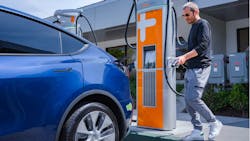ChargePoint Announces Restructuring as Blink Talks Future Charging Needs
Electric vehicle charging station maker ChargePoint Holdings Inc. has laid off about 10% of its workers as part of a “strategic corporate reorganization” that CEO Pasquale Romano said executives have been working on for months and which should reduce the company’s operating expenses by about $30 million a year, some 6% of the charging company’s first-half pace.
The recent layoffs mean California-based ChargePoint will incur around $8 million in charges largely due to severance benefits and facility-related expenses during the third quarter.
“[The restructuring is] quite distinct from many of the other financial parameters in the company […] It's largely something we’ve done as we've continued to optimize how we execute internally,” Romano said on a conference call with analysts Sept. 6. “Over the last eight quarters or so, operating expenses have been operating in a fairly tight band and we've been improving operating leverage over that period of time.”
Financially, ChargePoint failed to deliver. The company, which is the largest distributor of electric vehicle charging in North America, posted revenue of $150 million, lower than analysts’ forecasts, and it ended the quarter with adjusted EBITDA of -$81.2 million.
Looking forward, executives expect revenue for Q3 (ending Oct. 31) to be between $150 million and $165 million, which would be about 25% higher than in the same period last year.
Shares of ChargePoint (Ticker: CHPT) fell after reporting earnings, opening at $5.93 per share after closing at $7.06 the previous day. As of writing, shares are trading at $6.04, bringing its market capitalization to about $2.1 billion.
Romano also discussed the reorganization and the company’s overall position at the Goldman Sachs Communicopia & Technology Brokers Conference a day after reporting earnings. He said the restructuring was “planned, not financially motivated,” so ChargePoint could achieve its positive adjusted EBITDA goal by Q4 of 2024.
He also answered questions about permitting reform, NEVI and the IRA, comparing the complicated process of fixing a leaky deck to how construction projects are tangled up dealing with EV charging projects.
“You can't solve just the permanent problem for EV charging, because if that's in conjunction with a complete hard-scape reorganization of a parking lot, they are going to be like, ‘Well, it’s really great that I got the EV charging permit but I'm not going to have the backhoe come out and tear up the parking lot until I get these six other permits,’” he said. “So, you really need general permit streamlining to actually happen and then the utility interconnect streamlining also has to happen if a utility upgrade is required on the site. So, it's a lot more complicated than just get EV charging permitted.”
With EVs expected to grow to more than a fourth of the car market by 2030—and possibly up to 40%, according to S&P Global Mobility—more than 2 million Level 2 and 3 chargers will be needed across the nation. Thus far, the Bipartisan Infrastructure Law has pledged $7.5 billion and 500,000 chargers to the cause as it tries to achieve the Biden Administration’s goal of net-zero emissions in the U.S. by 2050.
Blink Charging Co. CEO Brendan Jones echoed the need for more chargers in a fireside chat at the 2023 Barclays CEO Energy-Power Conference.
“If we look at charging, it’s this astronomical number of 339 to 490 million chargers needed. Right now, there’s not enough chargers being produced by a single company to get anywhere near that number, so that signifies a tremendous opportunity for growth,” Jones said.
A 2022 McKinsey study estimates that in the United States alone, more than 30 million chargers would be needed. While the overwhelming majority would be residential chargers, it’s still a tough hill to climb.
“By 2030, we need 30 million chargers. About 4 million are in the ground today and operational, leaving a gap of 26 million that companies like Blink, ChargePoint, others need to fill,” Jones said, “If you look at the investments, it’s $100 billion worth of capital investments needed by 2040.”
And most of those chargers, whether residential or commercial, will need to be L2, according to Jones.
“90% of all kilowatts dispensed globally, and this is what I call an undisputed fact, McKinsey, Bloomberg … have validated that 90% of the kilowatts dispensed will come from L2chargers, not DC fast chargers,” he said. “It’s L2 chargers that will carry the lion share of charging in the U.S. and globally.”
Fast chargers have been a prominent EV topic this summer, with several car manufacturers and charging companies announcing their switch from the widely accepted CCS charger to the NACS charger touted by Tesla. Most recently, Honda and Fisker have been the most recent additions to join Tesla’s Supercharger network, with vehicles to be equipped with the NACS port starting in 2025.
Blink, which has sold 987 DC chargers this year, a record for the company, had a glowing Q2 compared to ChargePoint. It beat revenue estimates by $9 million, coming in at $32.8 million for the quarter, a 186% year-over-year increase.
Jones called the growth “almost exclusively organic,” driven by strong demand for equipment and services in the U.S. Executives boosted the company’s revenue guidance by $10 million to a range of $110 million to $120 million.
